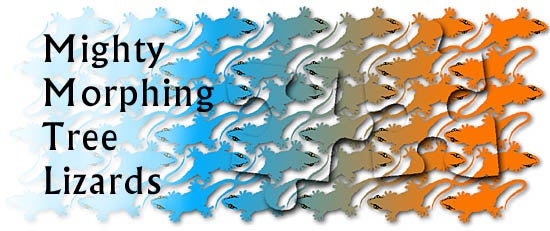
Illustrated by: Dr. Biology
A group of children are busy playing in the park. They look up as a tough-looking boy approaches. "Hey, this is my playground!" he says with a nasty smirk. "You'd better get outta here now or you'll be sorry!" The other children flee in search of another place to play. Every playground has its bullies. Why do some people's instincts tell them to fight, and other people would rather just run away? Many animals behave the same way. Biologists at Arizona State University hope that by learning more about animal behavior, they will also be able to understand why people act the way they do. Michael Moore is a professor of biology and an expert on animal behavior. He and others in his laboratory think that hormones are part of the answer.
Moore and his partners study hormones and behavior in tree lizards. If you live in the Phoenix area, you have probably seen these lizards in your own back yard. Male tree lizards are handy for studying behavior because they come in multiple forms, or "morphs," that look and act different. One male morph has an orange dewlap with a blue spot in the center. These males are very aggressive and territorial, like the school yard bully. The other male morph has a solid orange dewlap with no blue spot. Like the other kids at the playground, orange males prefer to avoid arguments. They wander from place to place instead of trying to settle their own land.

The tree lizards' dewlaps are like flags that tell other lizards how they behave. An orange-blue dewlap might say "put up your dukes!" Orange dewlaps say "excuse me, I was just leaving." People can also use these visual signals to determine how aggressive a lizard is. This is very helpful for biologists who study tree lizard behavior.
One of Moore's discoveries is that the hormones testosterone and progesterone make the male tree lizard morphs different. When they are babies, orange-blue tree lizards have lots of testosterone and progesterone. Orange males have much less. Because their hormone levels are different, the two types of males develop differently. High levels of these hormones cause males to develop orange-blue dewlaps, and think like fighters. In fact, Moore can change a timid orange male into a feisty orange-blue male by increasing its testosterone or progesterone levels.
If hormones change the way a tree lizard's dewlap looks, do they also change its brain? Moore's research team is now doing experiments to find out whether orange-blue males' brains look different from those of orange males. They are particularly interested in the areas in the brain that control aggressive behavior. If these areas do look different, then maybe tree lizards can teach us something about how hormones affect the mysterious workings of the mind.
References:
Additional photographs courtesy of Brad and Lynn Weinert.
Read more about: Mighty Morphing Tree Lizards
Bibliographic details:
- Article: Mighty Morphing Tree Lizards
- Author(s): Danika Painter
- Publisher: Arizona State University School of Life Sciences Ask A Biologist
- Site name: ASU - Ask A Biologist
- Date published:
- Date accessed:
- Link: https://askabiologist.asu.edu/explore/tree-lizards
APA Style
Danika Painter. (). Mighty Morphing Tree Lizards. ASU - Ask A Biologist. Retrieved from https://askabiologist.asu.edu/explore/tree-lizards
Chicago Manual of Style
Danika Painter. "Mighty Morphing Tree Lizards". ASU - Ask A Biologist. . https://askabiologist.asu.edu/explore/tree-lizards
Danika Painter. "Mighty Morphing Tree Lizards". ASU - Ask A Biologist. . ASU - Ask A Biologist, Web. https://askabiologist.asu.edu/explore/tree-lizards
MLA 2017 Style

Ornate Tree Lizard (Urosaurus ornatus) used with permission of Brad and Lynn Weinert.
Be Part of
Ask A Biologist
By volunteering, or simply sending us feedback on the site. Scientists, teachers, writers, illustrators, and translators are all important to the program. If you are interested in helping with the website we have a Volunteers page to get the process started.


